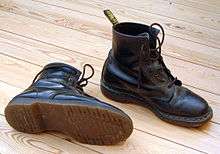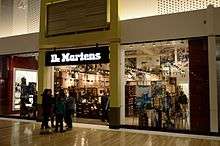Dr. Martens
Dr. Martens is an English footwear and clothing brand, headquartered in Wollaston in Wellingborough, Northamptonshire. They also make a range of accessories – shoe care products, clothing, bags, etc. In addition to Dr. Martens, they are also commonly known as Doc Martens, Docs or DMs.[1] The footwear is distinguished by its air-cushioned sole (dubbed Bouncing Soles), upper shape, welted construction and yellow stitching. The boots have been the choice of footwear among various groups in British culture: in the 1960s skinheads started to wear them, "Docs" or "DMs" being the usual naming, and by the late 1980s, they were popular among scooter riders, punks, goths, some new wave musicians, and members of other youth subcultures, most notably the grunge fashion scene in the early nineties.[2][3]
 | |
| Private company | |
| Industry | Footwear |
| Founded | 1947 |
| Founder | Klaus Märtens |
| Headquarters | United Kingdom |
| Products |
|
| Owner | Permira |
| Website | www |
In 2006, Griggs' 1460 Dr. Martens AirWair boot was named in the list of British design icons which included Concorde, Mini, Jaguar E-Type, Aston Martin DB5, Supermarine Spitfire, Tube map, World Wide Web and the AEC Routemaster bus.[4]
History
Founding
Klaus Märtens was a doctor in the German army during World War II. While on leave in 1945, he injured his ankle while skiing in the Bavarian Alps. He found that his standard-issue army boots were too uncomfortable on his injured foot. While recuperating, he designed improvements to the boots, with soft leather and air-padded soles made of tires.[5] When the war ended and some Germans recovered valuables from their own cities, Märtens took leather from a cobbler's shop. With that leather he made himself a pair of boots with air-cushioned soles.[6]

Märtens did not have much success selling his shoes until he met up with an old university friend, Herbert Funck, a Luxembourger, in Munich in 1947. Funck was intrigued by the new shoe design, and the two went into business that year in Seeshaupt, Germany, using discarded rubber from Luftwaffe airfields. The comfortable soles were a big hit with housewives, with 80% of sales in the first decade to women over the age of 40.[7]
United Kingdom
Sales had grown so much by 1952 that they opened a factory in Munich. In 1959, the company had grown large enough that Märtens and Funck looked at marketing the footwear internationally. Almost immediately, British shoe manufacturer R. Griggs Group Ltd. bought patent rights to manufacture the shoes in the United Kingdom.[8] Griggs anglicised the name to "Dr. Martens", slightly re-shaped the heel to make them fit better, added the trademark yellow stitching, and trademarked the soles as AirWair.[4]

The first Dr. Martens boots in the United Kingdom came out on 1 April 1960 (known as style 1460 and still in production today, although in many variations), with an eight-eyelet cherry red coloured smooth leather design. The three eyelet shoe arrived exactly one year later with the style number 1461 (1/4/61). Dr. Martens boots were made in their Cobbs Lane factory in Wollaston, Northamptonshire (which is still operating today).[7] In addition, a number of shoe manufacturers in the Northamptonshire area and further afield produced the boots under licence, as long as they passed quality standards. The boots were popular among workers such as postmen, police officers and factory workers. By the later 1960s, skinheads started to wear them, "Docs" or "DMs" being the usual naming, and by the late 1970s, they were popular among scooter riders, punks, some new wave musicians, and members of other youth subcultures.[2] The shoes' popularity among politically right-wing skinheads led to the brand gaining an association with violence.[2] Alexei Sayle sang the song "Dr. Martens' Boots" in a 1982 episode of the British TV comedy The Young Ones.[9]
In 1989 Accent Group became the first manufacturer of Dr. Martens outside of the United Kingdom, obtaining the rights to make them in Dunedin, New Zealand, which they did for several years.[10] The boots and shoes became popular in the 1990s as grunge fashion arose. In late November 1994, a six-storey Dr. Martens department store was opened in Covent Garden in London which sold food, belts, and watches, as well as shoes. At this time the R. Griggs company employed 2,700 people, expected to earn annual revenue of £170 million, and could produce up to 10 million pairs of shoes per year.[11][12] Dr. Martens sponsored Rushden & Diamonds F.C. from 1998 to 2005. Diamonds approached owner and local businessman, Max Griggs to request sponsorship from his company. A new main stand was built at Nene Park in 2001, named the Airwair Stand. Dr. Martens were also the principal sponsors of Premier League club, West Ham United F.C., renaming the upgraded west stand 'The Dr Martens Stand' until 2009. In 1999 Dr. Martens battled it out in counter lawsuits in US Courts. Dr. Martens brand began a number of lawsuits in 2016 based on trademark law primarily.[13]
Asia
In the 2000s, Dr. Martens were sold exclusively under the AirWair name, and came in dozens of different styles, including conventional black shoes, sandals and steel-toed boots. AirWair International's revenue fell from US $412 million in 1999 to $127 million in 2006.[14] In 2003, the Dr. Martens company came close to bankruptcy.[15] On 1 April that year, under pressure from declining sales, the company ceased making shoes in the United Kingdom,[16] and moved all production to China and Thailand. Five factories and two shops were closed in the UK, and more than 1,000 of the firm's employees lost their jobs.[17] Following the closures, the R. Griggs company employed only 20 people in the UK, all of whom were located in the firm's head office.[18] Five million pairs of Dr. Martens were sold during 2003, which was half the level of annual sales during the 1990s.[19]

In 2004 a new range of Dr. Martens was launched in an attempt to appeal to a wider market, and especially young people. The shoes and boots were intended to be more comfortable, and easier to break in, and included some new design elements.[19] Dr. Martens also began producing footwear again at the Cobbs Lane Factory in Wollaston, England in 2004. These products are part of the "Vintage" line, which the company advertises as being made to the original specifications.[20] Sales of these shoes are low in comparison to those made in Asia, however; in 2010, the factory was producing about 50 pairs per day.[7] In 2005, the R. Griggs company was given an award by the "Institute for Turnaround" for implementing a successful restructure.[15]
Worldwide sales of Dr. Martens shoes grew strongly in the early 2010s, and in 2012 it was the eighth fastest-growing British company.[21] Over 100 million pairs of Dr. Martens shoes have been sold from 1960 to 2010, and in 2010, the company offered 250 different models of footwear.[7] The R. Griggs company opened 14 new Dr. Martens retail stores in the United Kingdom, United States and Hong Kong between 2009 and 2011,[22] and also launched a line of clothing during 2011.[23]
The private equity company Permira acquired R. Griggs Group Limited (the owner of the Dr. Martens brand) for £300 million in October 2013.[24]
In 2018 ten million pairs of Dr. Martens shoes were produced. Of these, only one percent were made in the UK.[25] Annual revenue in 2019 was £454 million, six times more than in 2013. The most popular model remained the 1460 boots.[26] In 2019 Dr. Martens announced plans to double the production of shoes and boots in the UK, to 165,000 pairs annually in 2020.[27] Dr Martens' design studio is located in Camden Town, London.[26]
In 2019 The Guardian reported concerns that the quality of Dr. Martens shoes had declined since either production was moved to Asia or Permira acquired the brand. Many of the newspaper's readers reported that recently-produced Dr. Martens products did not last as long as older models. In response, the company stated that there has been no change in the materials used or production processes since manufacturing was moved to Asia and only 0.5 percent of the pairs of shoes it produces are defective.[28]
Gallery
 Distinctive yellow stitching on Dr. Martens shoe.
Distinctive yellow stitching on Dr. Martens shoe. Inside of pre-2003 Dr. Martens made in England.
Inside of pre-2003 Dr. Martens made in England. Inside of post-2003 Dr. Martens made in Thailand.
Inside of post-2003 Dr. Martens made in Thailand. Sole of pre-2003 Dr. Martens made in England
Sole of pre-2003 Dr. Martens made in England Sole of post-2003 Dr. Martens made in Thailand.
Sole of post-2003 Dr. Martens made in Thailand.- Dr. Martens logo stamped on the outer side of a boot.
- Floral-patterned Dr. Martens boots
 cherry red colour Dr. Martens 1461 shoes
cherry red colour Dr. Martens 1461 shoes
See also
References
- England and Wales High Court (Chancery Division) Decisions. "R. Griggs Group Ltd v. Evans [2003] EWHC 2914 (Ch)". British and Irish Legal Information Institute. p. 1. Retrieved 4 March 2020.
- Manzoor, Sarfraz (31 October 2010). "Dr Martens at 50: these boots were made for… everyone". The Observer. Retrieved 25 July 2012.
- "11 Ways '90s Grunge Influenced StreetwearPearl Jam vs. A$AP Mob". Complex. Retrieved 23 November 2017.
- "Long list unveiled for national vote on public's favourite example of Great British Design". BBC. 18 November 2016.
- Martin Roach: Dr. Martens The Story of an icon, 2003
- "About Dr, Martens". dmusastore.com. Retrieved 8 October 2010.
- Mazein, Elodie (2 April 2010). "Dr Martens 50 years old and still an icon to boot". The Sydney Morning Herald. Retrieved 23 August 2012.
- "R. Griggs Group Ltd". hoovers.com. Archived from the original on 31 July 2010. Retrieved 8 October 2010.
- "The Young Ones: Dr Marten Boots". BBC. 24 May 2010. Retrieved 17 August 2020.
- "Our Brands > Dr. Martens". accentgr.com.au. Accent Group Limited. Retrieved 15 December 2019.
- Ipsen, Erik (17 November 1994). "Doc Martens to Stomp Into London". The New York Times. Retrieved 22 August 2012.
- Menkes, Suzy (29 November 1994). "London Launch For Hip Shoes: Flagship For Doc Martens". The New York Times. Retrieved 22 August 2012.
- "The Fashion Law: a Leading Source for Fashion Law and the Business of Fashion". Archived from the original on 15 September 2017.
- Newman, Andrew Adam (3 December 2007). "An Antifashion Classic Returns". The New York Times. Retrieved 25 July 2012.
- Muston, Samuel (3 November 2010). "The Timeline: 50 Years of Dr Martens". The Independent. Retrieved 21 August 2012.
- "Dr Martens factories close". BBC News. 23 March 2003. Retrieved 8 October 2010.
- Pyke, Nicholas (26 October 2002). "Dr Martens is on its uppers". The Guardian. Retrieved 25 July 2012.
- "Anger as Dr Martens closure looms". BBC News. 12 December 2002. Retrieved 26 August 2012.
- Browne, David (7 November 2004). "Footwear Darwinism: Doc Martens Evolve". The New York Times. Retrieved 22 December 2014.
- "Increased demand for vintage Dr Martens fuels expansion". BBC News. 29 July 2011. Retrieved 25 July 2012.
- Cochrane, Lauren (19 July 2012). "Dr Martens enjoy comeback with best-selling season ever". The Guardian. Retrieved 22 August 2012.
- "No bovver as Docs make quick profit". Northamptonshire Telegraph. 13 April 2012. Archived from the original on 21 April 2013. Retrieved 22 August 2012.
- "Dr. Martens launches clothing line". The Independent. 19 April 2011. Retrieved 21 August 2012.
- "Dr Martens owner is bought by Permira", BBC News, London, 24 October 2013. Retrieved on 7 February 2014.
- Romeo, Claudia (5 June 2018). "US Inside Dr. Martens' only UK factory where its iconic Made In England range has been manufactured since 1960". Business Insider. Retrieved 13 June 2018.
- Wood, Zoe (17 August 2019). "Oh so pretty … political upheaval credited for Dr Martens sales boost". The Guardian. Retrieved 26 December 2019.
- "Dr Martens invests £2m in Northampton site". BBC News. 27 February 2019. Retrieved 14 March 2019.
- Collinson, Patrick; Smithers, Rebecca. "Dr Martens: are things going wrong with the UK's beloved brand?". The Guadian. Retrieved 26 December 2019.